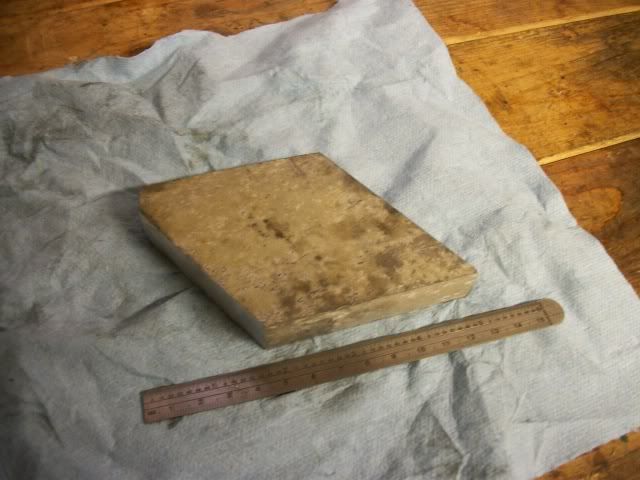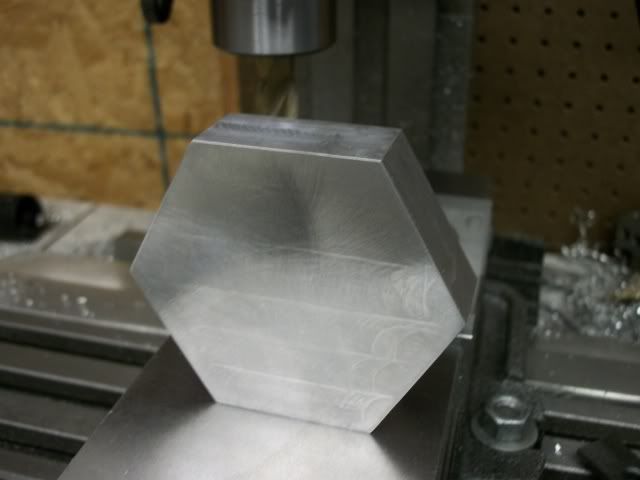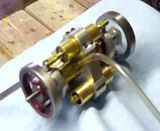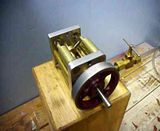- Joined
- Dec 2, 2008
- Messages
- 971
- Reaction score
- 8
Last year I built a three cylinder axial piston engine with a nutating wobble plate running on a commercial ball bearing. The project was a lot of fun and experimentation and not a lot of planning. I would conceive a part, model it in Alibre', build it, re draw it to actual dimensions of the part while throwing a lot of metal at the wall of shame. I designed some parts while I was building them and experimented with methods and materials. I started with almost no equipment, a well worn and worn out Unimat, a hacksaw, some files and butane torches.
The first actual running engine was built with just this equipment. It was so much fun, I decided to get serious about this hobby, get some machines, and learn how to use them. I bought a used 9x20 HF lathe in excellent condition and then added a Hf Micro Mill and within a few months exchanged it for the Mini Mill (X2) and began the pain/pleasure realization that I need more accessories. I added a Rotary Table with Dividing Head, and more recently a Boring Head and at long last a proper Milling Vice and Hold Down clamps. And of course, an array of end mills and collets.
During this process of acquisition and learning I started a few ambitious projects and shelved them as I realized that I wasn't ready for some of the challenges. I did actually complete the three cylinder engine, and it ran better than I had hoped, even though some of the design elements were crude. I set about building a second and slightly improved version, which was also completed. I then came up with the idea of combining the two engines on a common shaft and calling it a six cylinder engine. It was completed, photographed, videoed, and posted but never quite lived up to my expectations. There were so many bodged together components that needed to be refined that I lost interest in it, disassembled it, and put it away on a high shelf, and sometimes cannibalized it for parts for some other project. I couldn't reassemble it now, if I wanted to.
I came across it the other day and said to myself, If I were to do that over, it would be a lot different, so I started planning. Some of the design changes are cosmetic. Most are aimed at improved performance and reliability. The new design has better sealing, better balance, is about 2/3 the size of the earlier design while retaining the same displacement. It is a true opposed piston design with six pistons running head to head in three axial cylinders with no cylinder heads. A single rotary valve with isolated intake and exhaust porting eliminates the valve blowby common to drive shaft mounted rotary valves.
If you want to follow along, I'll try to explain the changes and the reasons for them as I go along.
If you want to see the original, here is the link to the thread.
http://www.homemodelenginemachinist.com/index.php?topic=5977.0
continued on
http://www.homemodelenginemachinist.com/index.php?topic=6707.0
This is the first part to be made. The cylinder block and cylinders.

The first actual running engine was built with just this equipment. It was so much fun, I decided to get serious about this hobby, get some machines, and learn how to use them. I bought a used 9x20 HF lathe in excellent condition and then added a Hf Micro Mill and within a few months exchanged it for the Mini Mill (X2) and began the pain/pleasure realization that I need more accessories. I added a Rotary Table with Dividing Head, and more recently a Boring Head and at long last a proper Milling Vice and Hold Down clamps. And of course, an array of end mills and collets.
During this process of acquisition and learning I started a few ambitious projects and shelved them as I realized that I wasn't ready for some of the challenges. I did actually complete the three cylinder engine, and it ran better than I had hoped, even though some of the design elements were crude. I set about building a second and slightly improved version, which was also completed. I then came up with the idea of combining the two engines on a common shaft and calling it a six cylinder engine. It was completed, photographed, videoed, and posted but never quite lived up to my expectations. There were so many bodged together components that needed to be refined that I lost interest in it, disassembled it, and put it away on a high shelf, and sometimes cannibalized it for parts for some other project. I couldn't reassemble it now, if I wanted to.
I came across it the other day and said to myself, If I were to do that over, it would be a lot different, so I started planning. Some of the design changes are cosmetic. Most are aimed at improved performance and reliability. The new design has better sealing, better balance, is about 2/3 the size of the earlier design while retaining the same displacement. It is a true opposed piston design with six pistons running head to head in three axial cylinders with no cylinder heads. A single rotary valve with isolated intake and exhaust porting eliminates the valve blowby common to drive shaft mounted rotary valves.
If you want to follow along, I'll try to explain the changes and the reasons for them as I go along.
If you want to see the original, here is the link to the thread.
http://www.homemodelenginemachinist.com/index.php?topic=5977.0
continued on
http://www.homemodelenginemachinist.com/index.php?topic=6707.0
This is the first part to be made. The cylinder block and cylinders.











